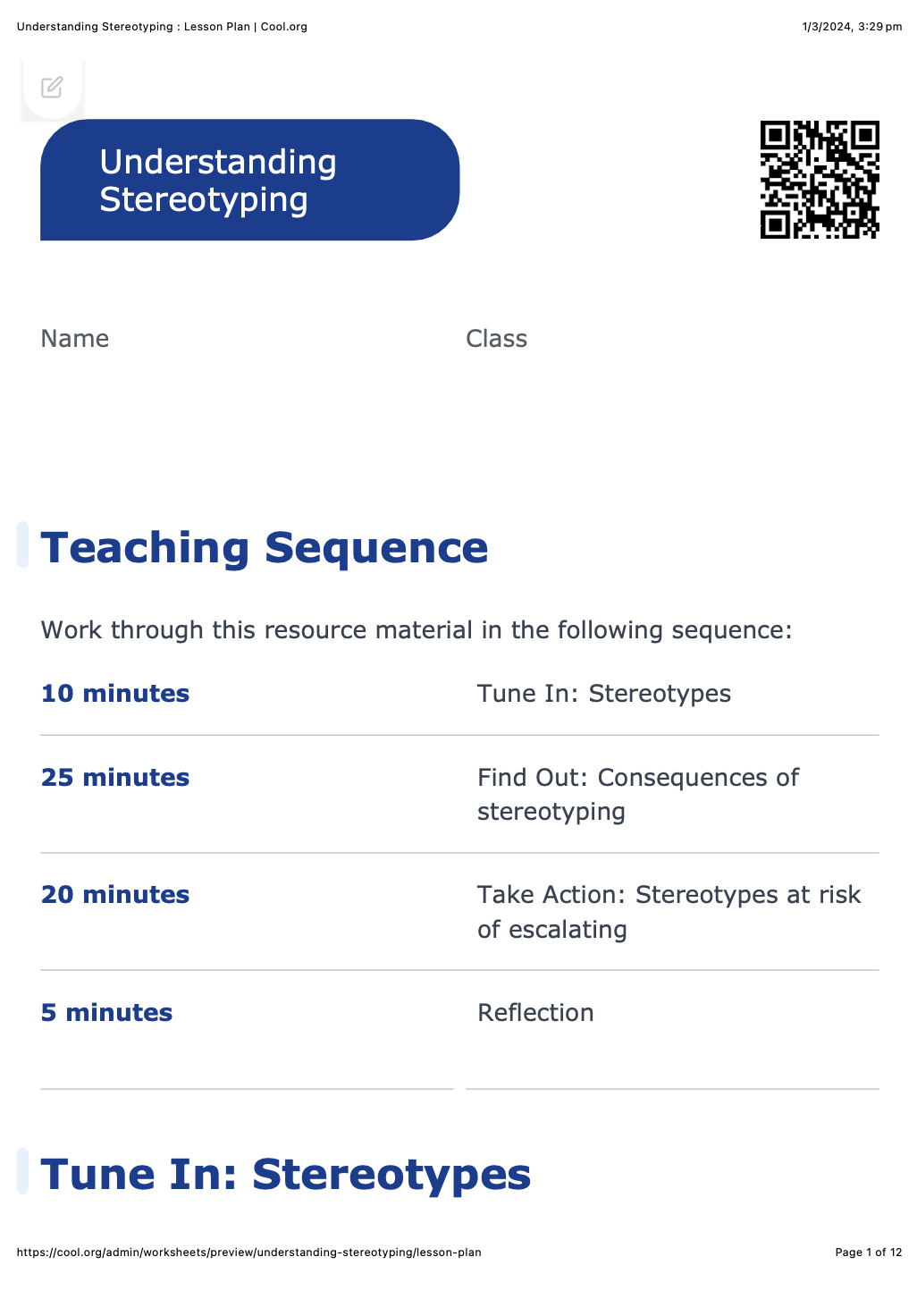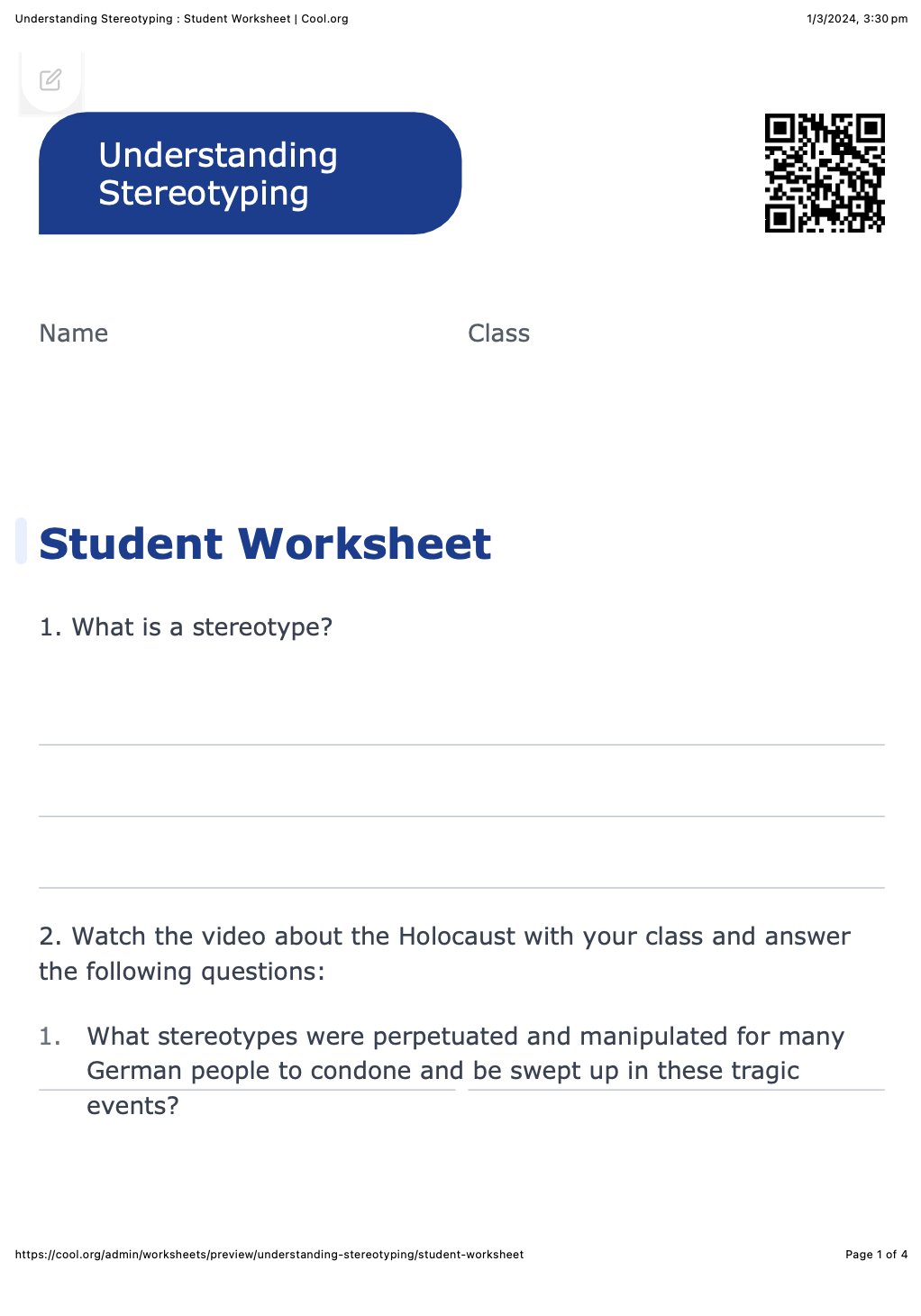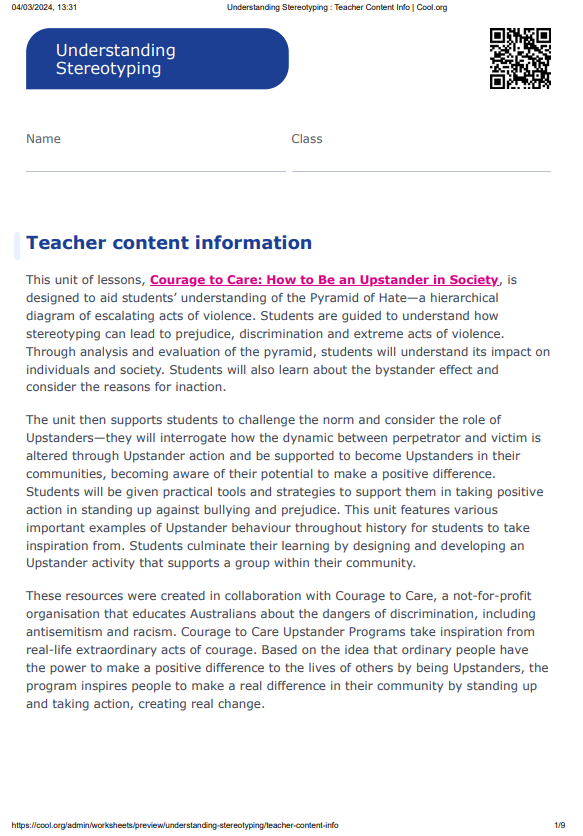Lesson summary
Students take a deeper dive into the causes and effects of discrimination by examining stereotyping. They consider ways to define and identify stereotyping and reflect on their own attitudes and behaviours. Students explore the potential consequences of how stereotyping can lead to prejudice, discrimination and violence.
Learning intentions:
Students will...
- understand stereotyping and investigate its potential consequences
- explore examples that allow them to understand how stereotyping can lead to violence and hate
- consider ways to counteract and prevent stereotyping.
Success criteria:
Students can...
- define stereotyping and provide examples of it
- explain how stereotyping can lead to acts of violence and hatred
- outline ways to counteract and prevent stereotyping.
Lesson guides and printables
Curriculum links
Select your curriculum from the options below.
Lesson details
Skills
This lesson is designed to build students’ competencies in the following skills:
- critical thinking
- collaboration
- communication
- curiosity
- empathy
- ethical understanding
- reflection
- social skills
Curriculum Mapping
Australian Curriculum (v9.0) content description:
Year 9 & 10 Health and Physical Education
- Analyse factors that shape identities and evaluate how individuals influence the identities of others (AC9HP10P01).
- Evaluate the influence of respect, empathy, power and coercion on establishing and maintaining respectful relationships (AC9HP10P04).
Victorian Curriculum content description:
Year 9 & 10 Health and Physical Education
- Plan, implement and critique strategies to enhance the health, safety and wellbeing of their communities (VCHPEP149)
- Critique behaviours and contextual factors that influence the health and wellbeing of their communities (VCHPEP151)
General capabilities: Critical and Creative Thinking, Ethical Understanding, Intercultural Understanding, Personal and Social Capability
Relevant parts of Year 9 & 10 achievement standards from the Australian Curriculum: Students can evaluate how attitudes and beliefs about equality, respect, diversity and inclusion influence the nature and quality of relationships. Students propose and justify strategies to manage online and offline situations where their own or others’ health, safety, relationships or wellbeing may be at risk. They apply and evaluate leadership approaches, collaboration strategies and ethical behaviours across a range of movement contexts.
UN Sustainable Development Goals
- Target 4.7: By 2030, ensure that all learners acquire the knowledge and skills needed to promote sustainable development, including, among others, through education for sustainable development and sustainable lifestyles, human rights, gender equality, promotion of a culture of peace and non-violence, global citizenship and appreciation of cultural diversity and of culture’s contribution to sustainable development.
- Target 16.1: Significantly reduce all forms of violence and related death rates everywhere.
Resources Required
- Art supplies
- Device capable of displaying audio-visual material
- Writing materials/a laptop for each student
Additional Info
These resources were created in collaboration with Courage to Care, a not-for-profit organisation that educates Australians about the dangers of discrimination, including antisemitism and racism. Courage to Care Upstander Programs take inspiration from real-life extraordinary acts of courage. Based on the idea that ordinary people have the power to make a positive difference to the lives of others by being Upstanders, the program inspires people to make a real difference in their community by standing up and taking action, creating real change.
Courage to Care offers face-to-face Upstander Programs at schools in most states. Delivered by teams of skilled and dedicated volunteers, Upstander Programs feature inspiring testimonies from Holocaust Survivor Speakers, promote acceptance of diversity within the community, and transform bystander behaviour by inspiring participants to become Upstanders.
Upstander Programs encourage participants to become aware of their potential to make a positive difference and offer practical tools for standing up against bullying and prejudice by empowering participants to take positive action – in the schoolyard, workplaces, and in our communities. Contact Courage to Care to find out more about booking an Upstander Program in your school.
Level of teacher scaffolding: Medium - High: Teachers may like to undertake further research on the Holocaust if they are unfamiliar with the content. If students have questions about the Holocaust, they could be directed to speak with their Humanities or History teachers, who may be more informed to respond to difficult questions.
Teachers should also be aware that this lesson will feature images of people from other cultures, and should ensure they feel confident in managing socially and emotionally safe class discussions. We highly recommend teachers read through the lesson content and Teacher Content Information before delivering this lesson.





Welcome back!
Don't have an account yet?
Log in with:
Create your free Cool.org account.
Many of our resources are free, with an option to upgrade to Cool+ for premium content.
Already have an account?
Sign up with:
By signing up you accept Cool.org's Terms and Conditions(Opens in new tab) and Privacy Policy(Opens in new tab).